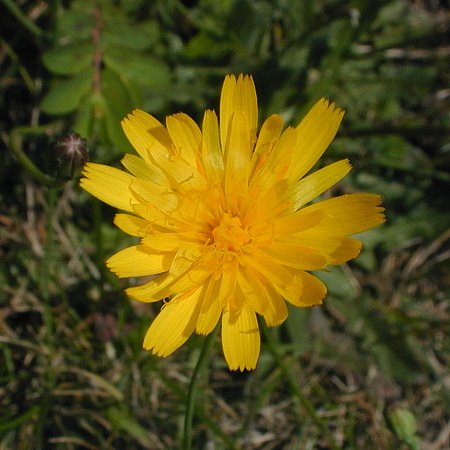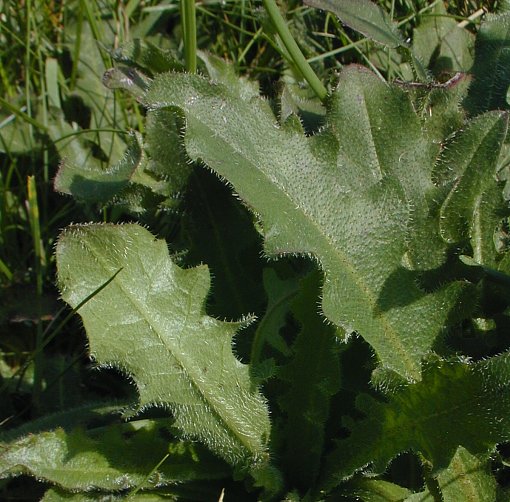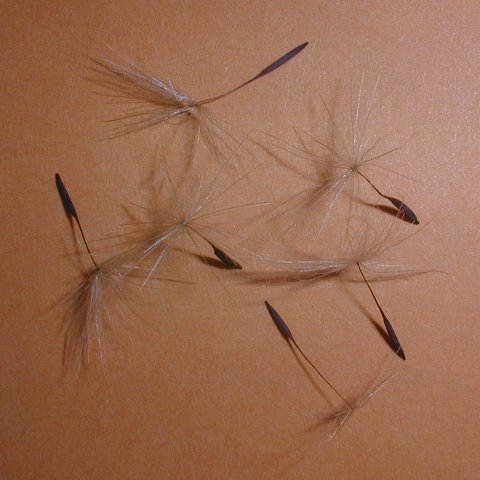Description: This herbaceous perennial plant consists of a rosette of basal leaves spanning up to 1' across, from which one or more flowering stalks develop. The basal leaves are up to 6" long and 2" across. They are oblanceolate, pinnatifid, ciliate, and sometimes coarsely dentate along their margins. Both the upper and lower surfaces of these leaves are covered with coarse white hairs. There is a conspicuous central vein that runs along the length of the lower surface of each leaf. The flowering stalks are up to 2' tall. They are hairless and usually sparingly branched; each of these branches terminates in a single yellow flowerhead spanning about 1–1½" across. There are a few alternate leaves along the flowering stalks; these leaves have been reduced to scales and are quite small. The foliage has a milky latex.

Each flowerhead consists of about 20-30 yellow ray florets and no disk florets. The ray florets spread outward from the center of the flowerhead; each of these florets is truncate with 5 small teeth along its outer edge. Toward the center of the flower are slender yellow styles that are bifurcated and recurved at their tips. The base of each flowerhead has several series of green bracts (phyllaries) that are oblong-linear and appressed together to form a short cylinder. Toward the tip of each bract, there is often a central mid-rib with coarse white hairs. The blooming period occurs from mid-summer to early fall and lasts about 2 months. Each floret is replaced by an achene with a thread-like beak that terminates in a tuft of white hairs. This beak is as long as, or longer, than the achene. The dark achene is somewhat flattened, ribbed, and narrowly spindle-shaped, tapering at both ends. The achenes are distributed by the wind. The root system produces a fleshy caudex with fibrous roots. This plant reproduces primarily by reseeding itself, although offsets may form a short distance from the mother plant.

Cultivation:
The preference is full sun, mesic to dry conditions, and a loam or
clay-loam soil. Other kinds of soil may be tolerated as well. This
plant tolerates occasional mowing.
Range & Habitat:
The adventive Rough Cat's Ear is an uncommon plant that occurs
primarily in NE
Illinois, as well as Champaign and St. Clair counties (see Distribution
Map). It is originally from Eurasia. Habitats include lawns
and areas near dwellings, vacant lots, grassy areas along railroads and
roadsides, and waste areas. This species usually occurs in disturbed
urban areas – thus far, it has not been invasive of natural areas.

Faunal
Associations:
According to Müller, the nectar and pollen of the flowerheads attract
primarily bees, including honeybees, bumblebees, Plasterer bees,
Andrenid bees, and Halictid bees. Syrphid flies occasionally feed on
the pollen and are probably ineffective at cross-pollination. The
webmaster observed the butterfly Colias eurytheme
(Orange Sulfur) visiting the flowerheads of several plants for nectar
while they were photographed. It seems likely that both White and
Sulfur butterflies visit the flowerheads for nectar. While the foliage
is somewhat bitter from its milky latex, pigs are reportedly fond of
the fleshy roots as a source of food.
Photographic Location:
An elevated grassy area along a strip mall in Champaign, Illinois. This
location was subjected to occasional mowing.

Comments: Rough Cat's Ear is one of many species in the Aster family that have flowerheads with yellow ray florets, a rosette of basal leaves, and foliage with milky latex. The most familiar member of this group of plants is Taraxacum officinale (Dandelion), although there are many others. Some species in this group are adventive from Eurasia, while others are native. To distinguish the different species in this group, it is necessary to consider the following key features: 1) the presence or absence of hair on the basal leaves, 2) the presence or absence of beaks and tufts of hair on the achenes, 3) whether or not the flowering stalks are branched, and 4) the appearance of the floral bracts. Rough Cat's Ear has hairy basal leaves, its achenes have long beaks that terminate in tufts of white hair, its flowering stalks are usually branched with scale-like alternate leaves, and the floral bracts are appressed together in an overlapping series. Dandelion differs from Rough Cat's Ear by its hairless (or nearly hairless) basal leaves, unbranched flowering stalks, and lower floral bracts that curl downward at the base of the flowerhead. Another similar species, Hypochaeris glabra (Smooth Cat's Ear) is a very rare adventive species in Illinois that has hairless basal leaves, and its outer achenes lack beaks.